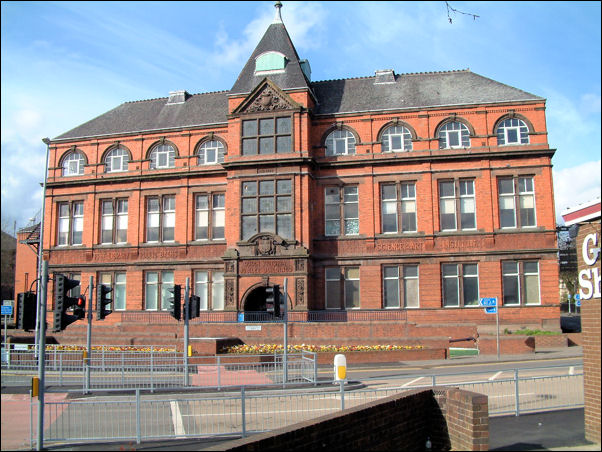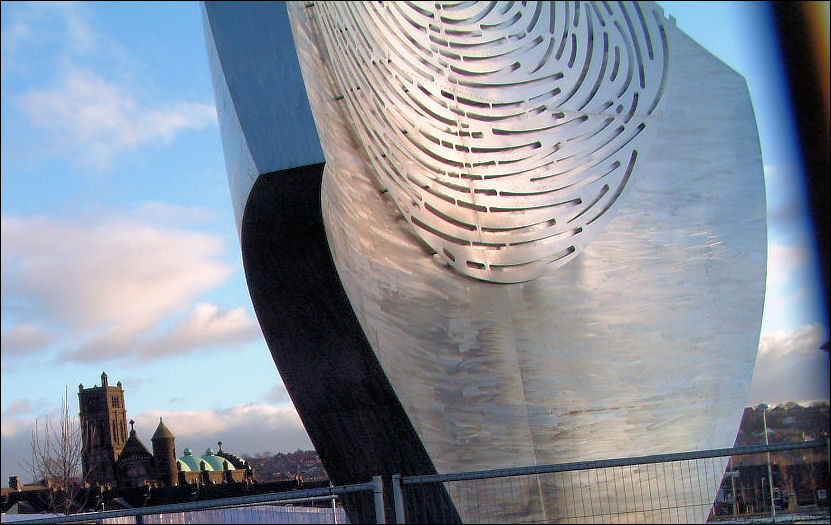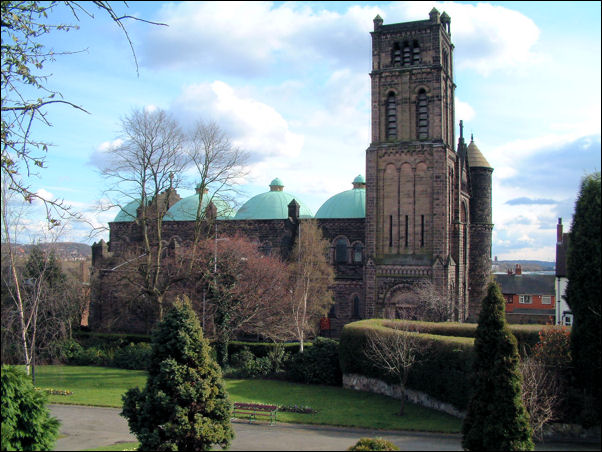The
sculpture, is based on a shard of pottery from Roman times, that was
found in an underground oven when the Wedgwood site was being
redeveloped. And it shows the fingerprint that can be seen on the
original shard and which is thought might date back hundreds of
years.
The
sculpture is 300 times larger than the shard it is based upon.
Fabricated in Stainless Steel, it
stands 35 ft high
by 27ft wide, and weighs 7.5 tons.
The stainless
steel sculpture, installed in 2009, contrasts with the terracotta
library building of the Victoria Institute built 120 years earlier
and also Father Ryan's 1920's - 30's amazing church with its huge copper domes.
|

|
On the day
of the unveiling a number of local children from Mill Hill School
placed Memory Capsules with data about Tunstall regarding, time,
history, and the future, in a special chamber adjacent to the
sculpture.
 more on "Tunstall Shard"
more on "Tunstall Shard"
|
|

Tunstall Public Library, formerly Victoria Institute,
and public baths, 1889
 more on the Victoria
Institute
more on the Victoria
Institute
“Libraries gave us
power” was the opening line from the Manic Street Preachers’ first
major hit ‘A Design for Life’, and reflected their pride in their
working-class upbringing in industrial South Wales, the line being
inspired by the main entrance to the Central Library in Newport
which contains an inscription of the said legend. The library was
built for the poor of the town around the turn of the 20th
century, a first class public facility to enable those less
fortunate to better themselves, the provision of the building driven
forward by the local Labour movement, hence the inscription:
“libraries gave us power”.
In Tunstall we have the
magnificent Victoria Institute.
Built in 1889 by the prolific A. R.
Wood, whose practice was based on Butterfield Place in the town, the
Victoria Institute forms part of what is left of the Jubilee
Buildings (which included a free library, art and science schools,
Public Baths on Greengate Street, and also a Fire Station that was
closed in 1926): a fine example of Victorian-era provision of
municipal facilities, and one from which modern local authorities
could learn great lessons from. |
|

In
the background is the Church of the Sacred Heart
|

Sacred
Heart (R.C.), Queen's Avenue - 1925-30
taken from Tunstall Park
Rusticated stone with copper domed roofs.
 more on the Sacred
Heart Church
more on the Sacred
Heart Church
The Roman Catholic Church of the
Sacred Heart on Queens Avenue, Tunstall, with its stunning copper
domed roofs visible for miles around, is one of North
Staffordshire’s major architectural statements, and was the vision
of one man – Father P. J. Ryan.
In 1925 Father Ryan appointed a
prominent architect – J. S. Brocklesby – and gave him a
challenging brief: to trump the local Protestants and build the
biggest, most imposing, and beautiful church in the area.
Brocklesby took up the challenge, but the trouble was, Father Ryan
had absolutely no intention of implementing his architect’s plans.
In fact he dragged Brocklesby all over Europe to draw inspiration
from continental places of worship, and his ideas grew and grew.
|
![]()